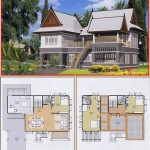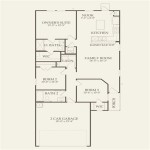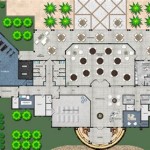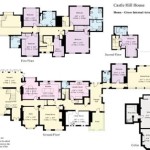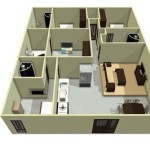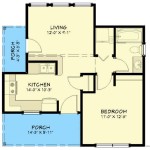Small House Plans for Northern Climates: Efficiency and Resilience
Designing and building a small house in a northern climate presents a unique set of challenges and opportunities. These regions, characterized by long, cold winters, heavy snowfall, and shorter daylight hours, demand careful consideration of energy efficiency, material selection, and overall design to create comfortable, sustainable, and resilient living spaces. Effective small house plans for northern climates prioritize minimizing heat loss, maximizing solar gain, and integrating durable, weather-resistant materials that can withstand harsh environmental conditions. This article explores key considerations for developing small house plans tailored to the specific demands of northern climates.
Optimizing Energy Efficiency in Design
Energy efficiency is paramount in small house designs for northern climates. A well-insulated and airtight building envelope is critical for minimizing heat loss and reducing heating costs. This begins with selecting high-performance insulation materials for the walls, roof, and foundation. Options include spray foam insulation, rigid foam boards, and dense-packed cellulose, each offering varying R-values and installation methods. The selection should align with the specific climate zone and construction techniques.
Beyond insulation, minimizing air infiltration is crucial. Air leaks can significantly contribute to heat loss, even in well-insulated buildings. Proper sealing of windows, doors, and any penetrations in the building envelope is essential. This involves using high-quality weather stripping, caulking, and sealing tapes to create an airtight barrier. Regularly inspecting and maintaining these seals is vital for long-term energy performance.
Window selection is another critical design element. High-performance windows with low-E coatings and argon gas fills can significantly reduce heat loss through the glass. Opting for triple-pane windows further enhances insulation. The orientation of windows also plays a role in energy efficiency. South-facing windows can capture solar heat during the day, reducing reliance on supplemental heating. However, strategically placed overhangs or shading devices may be necessary to prevent overheating during the summer months.
Incorporating passive solar design principles is an effective strategy for reducing heating loads. This involves orienting the house to maximize solar gain during the winter and minimize it during the summer. South-facing windows are ideal for capturing winter sunlight, while smaller windows on the north side reduce heat loss. Thermal mass materials, such as concrete or brick, can absorb and store solar heat during the day, releasing it slowly at night.
Efficient heating systems are also crucial. Options include high-efficiency furnaces, heat pumps, and wood stoves. Heat pumps are particularly effective in moderately cold climates, while wood stoves can provide a reliable source of heat when properly installed and maintained. Consider supplemental heating options, such as radiant floor heating, for enhanced comfort.
Ventilation is a key element often overlooked in energy-efficient homes. An airtight house requires a mechanical ventilation system to ensure adequate fresh air circulation and prevent moisture buildup. Heat recovery ventilators (HRVs) and energy recovery ventilators (ERVs) exchange heat between incoming fresh air and outgoing stale air, minimizing energy loss while providing ventilation.
Material Selection for Durability and Weather Resistance
The selection of durable and weather-resistant materials is essential for small houses in northern climates. These materials must withstand extreme temperature fluctuations, heavy snowfall, and potential ice damage. Choosing materials that are resistant to moisture, rot, and pests is also critical for long-term performance.
For exterior cladding, options include wood siding, fiber cement siding, metal siding, and brick. Wood siding provides a traditional aesthetic but requires regular maintenance to prevent rot and decay. Fiber cement siding offers a durable and low-maintenance alternative, while metal siding provides excellent weather resistance and longevity. Brick is a durable and fire-resistant option, but it can be more expensive.
Roofing materials should be capable of withstanding heavy snow loads and ice buildup. Options include asphalt shingles, metal roofing, and slate. Asphalt shingles are a cost-effective option, but they may require more frequent replacement than metal or slate. Metal roofing is highly durable and can shed snow easily, while slate is a long-lasting and aesthetically pleasing option.
Foundation materials should be resistant to frost heave and moisture penetration. Concrete foundations are commonly used in northern climates, but they must be properly designed and insulated to prevent frost damage. Insulated concrete forms (ICFs) provide enhanced insulation and can simplify construction. Consider a crawl space foundation or a slab-on-grade, depending on the specific soil conditions and site characteristics.
Window and door materials should be chosen for their thermal performance and durability. Wood windows offer a classic aesthetic but require regular maintenance to prevent rot and decay. Vinyl windows are a low-maintenance and energy-efficient option, while aluminum windows provide excellent strength and durability. Fiberglass windows combine the strength of aluminum with the insulation of vinyl.
Decking materials should be resistant to moisture and rot. Pressure-treated lumber is a cost-effective option, but it requires regular maintenance. Composite decking offers a low-maintenance alternative and is available in a variety of colors and styles. Consider using durable fasteners and hardware to ensure the longevity of the deck.
Attention to detail is crucial when selecting and installing materials. Proper flashing around windows, doors, and chimneys is essential for preventing water damage. Sealing all penetrations in the building envelope is critical for minimizing air leaks. Using quality sealants and adhesives will ensure a long-lasting and weather-resistant structure.
Designing for Compact Living and Functionality
Small house plans for northern climates must prioritize efficient space utilization and functionality. Every square foot should be carefully considered to maximize living space and minimize wasted space. Smart storage solutions, multi-functional spaces, and carefully planned layouts are essential for comfortable living in a small house.
Open floor plans can create a sense of spaciousness in a small house. Combining the living room, dining room, and kitchen into one large space allows for flexible use and easy circulation. Strategic placement of furniture can define distinct zones within the open space.
Multi-functional spaces can serve multiple purposes, maximizing the use of available square footage. A guest bedroom can double as a home office or a hobby room. A dining table can also serve as a workspace. Incorporating built-in storage solutions, such as bookshelves or cabinets, can further enhance functionality.
Loft spaces can provide additional living or sleeping area in a small house. Lofts are particularly well-suited for bedrooms or home offices. Ensure that the loft space meets all building code requirements for headroom and egress.
Smart storage solutions are essential for keeping a small house organized and clutter-free. Built-in storage, such as window seats with storage underneath, can maximize space utilization. Vertical storage, such as shelving and cabinets, can also help to keep belongings organized and off the floor.
Consider incorporating a mudroom or entryway for storing coats, boots, and other outdoor gear. This helps to keep dirt and snow from being tracked into the main living areas of the house. A well-designed mudroom can also serve as a buffer between the cold outdoors and the warm indoors.
Outdoor living spaces, such as decks or patios, can extend the living area of a small house during the warmer months. Strategically placed landscaping can provide privacy and create a relaxing outdoor environment. Consider incorporating a covered porch or pergola for protection from the elements.
Pay attention to the flow of the house. A well-designed layout should allow for easy circulation and minimize wasted space. Consider the placement of doors and windows to maximize natural light and ventilation. Ensure that the kitchen is efficiently designed for food preparation and storage.
Accessibility is an important consideration, especially for aging in place. Incorporate universal design principles, such as wider doorways, grab bars in bathrooms, and lever handles on doors, to make the house accessible to people of all ages and abilities.
By carefully considering energy efficiency, material selection, and functionality, it is possible to create small house plans that are perfectly suited for the challenges and opportunities of northern climates. These houses can provide comfortable, sustainable, and resilient living spaces that are both practical and aesthetically pleasing.

Like Our Smallest Creation The Hummingbird H1 New Snowbird 1 Is Just As Cute Offering A P Modern Style House Plans Unique Small Design

Alluring Small House Ideas Style Excellent Interior Design Unique Plans Floor Plan One Story

Winter S Most Wanted House Plans Houseplans Blog Com

15 Smart Design Choices For Cold Climates

Sample Htm Open Floor Plans With Discussion Of Your Many Options The Natural Home

Mountain Cottage Plan

Green Building In Cold Climates Inhabitat Interview With Bernat And Kate Of Maison Durable Portneuf

Net Zero House For A Cold Climate Jlc

180 Best Small Cottage Plans Ideas In 2024 Plan House Floor

27 Adorable Free Tiny House Floor Plans Craft Mart

